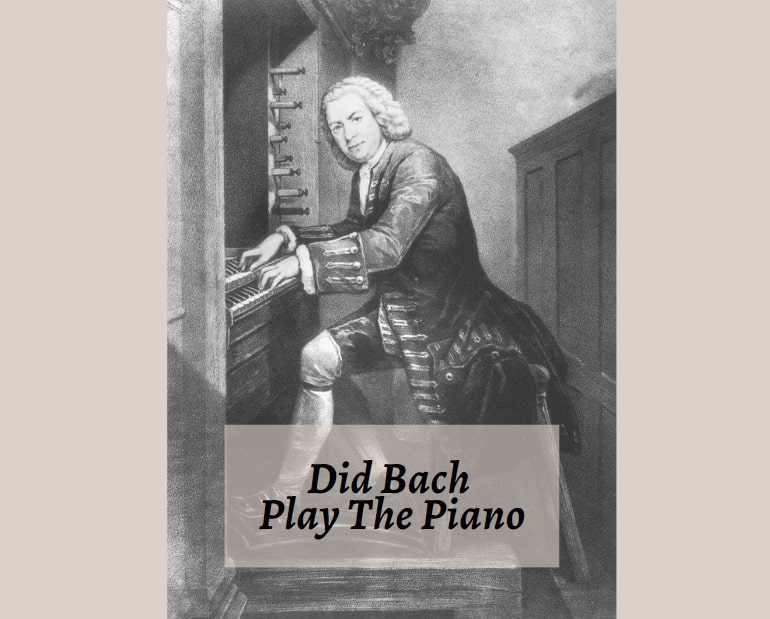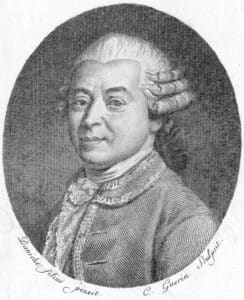
Many of us have either learned or heard the music of JS Bach played on the piano. As we find ourselves in the 21st Century, it might be hard to imagine JS Bach’s music played on a different instrument as we have become accustomed to so much of his keyboard output being performed that way.
The question that naturally emerges from this is whether or not JS Bach actually ever played the piano. Many of his keyboard works were not composed with this instrument in mind at all. Instead, the harpsichord or organ would have been at the top of JS Bach’s list.
Did Bach Play The Piano
One key factor to consider is the time in which JS Bach lived. He was one of the foremost composers of the Baroque Era. His year of birth was 1685 in Germany and he passed away on July 28th, 1750 in Leipzig, Germany.
This as you probably already know places JS Bach at the later end of the Baroque Era when many aspects of music and musical instruments were developing.
The musical innovations of JS Bach are a matter for another article, but around the 1700s a new instrument, the piano, began to gain a foothold in Italy.
Like the invention of the violin, the piano is thought to have begun its life in Italy through the vision, creativity, and craftsmanship of Bartolomeo Cristofori (1655-1731).
And, in a similar way that the violin came into being, the piano was also funded by that most influential family: the Medici family of Florence.
JS Bach was living and working in Germany, so did he know of the new instrument that came to the ears of the Italian composers?
It is quite probable that JS Bach could have read about it in translated journals of the time and we can be sure the concept had travelled to Germany as it would appear that one of the first pianos built was around 1732.
Gottfried Silbermann (1683-1753) was a noted builder of keyboards including organs, harpsichords, and later fortepianos.

Silberman had a formidable reputation for his instrumental creations perhaps with his great organ in the Hofkirche in Dresden, Germany standing as one of his most exceptional instruments.
As far as we can know, Silbermann designed his fortepiano closely on the descriptions he had available to him of Cristofori. There is also evidence to suggest that CPE Bach played a Silbermann fortepiano when accompanying none other than Frederick the Great who had purchased several of the instruments from Silbermann.
One account tells of a visit that JS Bach paid to his son in the 1730s. There he saw and played a Silbermann fortepiano. According to some stories, JS Bach was not enamoured by the Silbermann fortepiano saying that the keys were hard to play and that the treble end of the instrument sounded weak.
There was a further comment passed by JS Bach towards the end of his life when he again played on a Silbermann fortepiano around 1747. On this occasion, JS Bach was more kindly disposed towards the instrument.
So the story goes, JS Bach was given a theme by the King on which he fluently improvised a fugue. This piece JS Bach eventually developed in what we know today as ‘The Musical Offering’.
What these reports tell us with a strong degree of accuracy, is that JS Bach did in fact play the fortepiano and may or may not have been favourably disposed towards it. It is worth remembering that in the early part of the 18th Century when JS Bach played the Silbermann instruments, that were in their infancy.
They were not in any way a resemblance to the pianos we enjoy playing and listening to today. To illustrate this point, consider the characteristics of the Silbermann fortepiano from around 1749.
This particular modal is categorised as an FF/e3 model and would have been quite similar to the one JS Bach played. The design is essentially still that of Cristofori but towards the latter stages of its development.
Firstly, there are no pedals; no sustain or una corda. Instead, these options are hand-operated levers that would take some getting used to for pianists coming from the 21st Century. For JS Bach as a seasoned organist, this was perhaps a more natural feature.
The keyboard resembles that of a harpsichord with the black and white keys effectively reversed. Equally, the length of the keyboard was around five octaves. This when compared to today’s pianos seems quite restricted.
Small leather-covered wooden hammers hit the strings instead of being plucked as was common in harpsichords and clavichords. This alone could have felt quite unusual to the touch for JS Bach.
Quite often there is an assumption that JS Bach must have played the piano as he famously composed ‘The 48 Preludes and Fugues’, or ‘Das Wohltemperirte Klavier’.
The trouble is that even though the more literal translation of Klavier from German to English can be taken to be piano, really it simply refers to keyboard. JS Bach’s title was ‘Das Wohltemperirte Clavier’ which brings some clarity to the confusion.
Even though JS Bach wrote this extraordinary collection of pieces in celebration of the new well-tempered system of tuning that replaced meantone tuning, they were never intended for the fortepiano.
This amongst the purely technical challenges brings with it a host of performance considerations when studying these pieces and using a contemporary piano.
We can be certain that JS Bach did in fact play the early version of the fortepiano. In all probability, he would have been interested in the development of the new instrument and may have explored the fortepiano further if he has lived longer.
Clearly, CPE Bach enjoyed playing and composing for this instrument and maybe he would have persuaded his father to compose pieces for it. As it stands JS Bach composed no works for the fortepiano even though he was familiar with it.

The strings of a clavichord are struck, not plucked. Otherwise, a fairly interesting commentary.